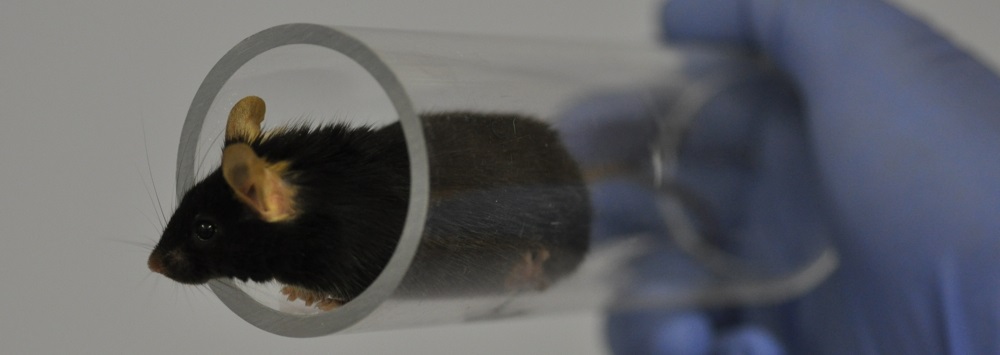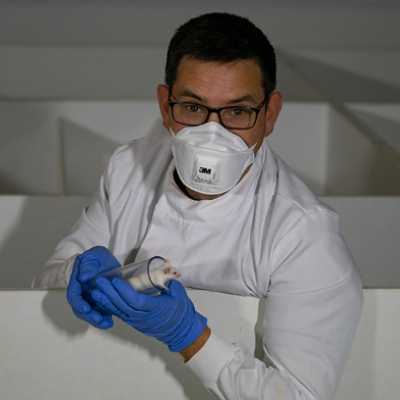The challenge
Mice are the most important laboratory animals used worldwide in industrial and academic biomedical research. Routine handling is an essential component however, how the animals are handled is well known to have profound effects on animal anxiety and stress (physiological and behavioural). This can affect both animal welfare and the reliability of scientific data collected. Until recently, there has been little attempt to understand how handling rodents differently might minimise these effects.
The research approach
University of Liverpool research, led by Professor Jane Hurst, provided strong scientific evidence that the tail handling method, until then universally recommended to pick up mice, induces aversion and high anxiety among lab mice. Professor Hurst showed that two new handling methods that she developed (use of a handling tunnel or cupping mice on the open hand without direct physical restraint) both led to low anxiety and handling stress, with the animals voluntarily approaching the handler. Professor Hurst demonstrated that the refined handling methods minimise the effects of handling on research data and provide more robust scientific outcomes, as well as improving the lifetime welfare of millions of mice in laboratories. Independent peer-reviewed studies in other laboratories in the USA, Japan, EU and UK were able to replicate these findings. Further research in Liverpool refined the handling methods, allowing practical implementation and replacement of tail handling in animal handling facilities utilising thousands of mice.
Working in partnership
Professor Hurst partnered with the UK National Centre for the Replacement, Refinement & Reduction of Animals in Research (NC3Rs), who strongly promote both refined handling methods as best practice in mouse handling. They have been widely advertised via NC3Rs newsletters, website, workshops, and training resources. Since 2016 the web resources have been accessed by users in 107 countries. Professor Hurst's team have also delivered more than 80 invited presentations / tutorials across 12 countries. In addition, major 3Rs centres internationally promote the use of the refined handling methods, referring their users to the NC3Rs resources. These include the North American 3Rs Collaborative (NA3RsC), Norecopa (Norway's 3Rs centre access by users across Europe), the Danish 3R-Center, the Swiss 3R Competence Centre, and Charité 3R.
In 2019 the UK Home Office Animals in Science Regulation Unit implemented a formal review to promote rapid uptake of these refined methods across all laboratory animal units in the UK housing mice and ensure that staff were given appropriate support to achieve this.
Implementation
It was through the use of these freely available training resources, and the added confidence in the science that the review provided, in addition to the numerous invited talks and demonstrations that Professor Hurst’s team have delivered, that the use of the new mouse handling techniques began to take off, with increasing numbers of UK institutions adopting the refined handling methods.
An independent online survey completed in early 2019 found that 61% of respondents working with mice used the refined methods (390 respondents from 27 countries). The survey results indicated that >80% of respondents who had heard of the methods were using them.
A 2019 UK Home Office ASRU survey of all UK licensed establishments (industry and academia) found that 68% of UK establishments were using the new handling methods, with 59% using these methods instead of picking mice up by the tail.
The biopharmaceuticals industry is a major user of laboratory mice, sensitive to the economic value of gaining reliable data from animal models and the ethical requirement to ensure the highest standards of animal welfare. Amongst others, the following have introduced refined handling methods:
- Novo Nordisk - in 2018 across Denmark, China and USA (approximately 44000 mice used per year)
- AstraZeneca - across all their facilities in the UK, USA and Sweden (approximately 121000 mice used per year)
As awareness spreads through further engagement by Professor Hurst’s team and partner organisations, adoption rates of the handling techniques will continue to increase.
Award winning team
The substantial impact of this research on laboratory rodent welfare has been recognised through several prestigious national and international awards for Professor Hurst:
- 2010 NC3Rs international prize for the most significant 3Rs advance in medical, biological or veterinary sciences
- 2019 Swiss Laboratory Science Association international prize for Refinement
- 2020 New Years Honours - Professor Hurst was awarded an OBE for her services to animal welfare
In addition, John Waters, animal care technician helped to provide practical advice and training resources to animal caretakers to encourage implementation in animal facilities. His effective role in promoting uptake has been recognised through the following awards:
- 2017 Andrew Blake Tribute Award 2017
- 2019 AAALAC International Fellowship 2019
- 2020 Times Higher Education Outstanding Technician of the Year
Back to: Faculty of Health and Life Sciences


